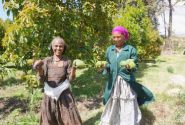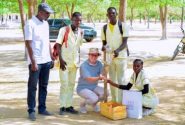SEOUL, South Korea (12 September, 2012)_The increased cultivation of açaí — the purple fruit that dangles from palms in the Brazilian rainforest and is touted by many celebrities as the number one superfood for ‘age-defying beauty’ – may be one of the reasons for the country’s staggering increase in forest cover over the past two decades, scientists said at the World Conservation Congress last week.
“It is actually replacing cattle pastures in certain areas of the Amazonian floodplain,” said Christine Padoch, Director of forests and livelihoods research at the Center for International Forestry Research (CIFOR). She was speaking at a workshop organised by CIFOR and Bioversity on managing wild systems and species for global food security.
The Brazilian Amazon, covering 4.1 million square kilometers, accounts for one-third of the world’s remaining tropical forests. While deforestation fell by 76 percent between 2004 and 2010, the expansion of agribusiness into the country’s forest and grassland in recent years has seen swathes of forests transformed for agricultural and cattle ranching activities.
But in the estuary of the Amazon where açaí (pronounced ah-sigh-ee) is native, local farmers are transforming natural forests of the fruit so that they can meet global demand. In other cases they follow a shifting cultivation trajectory – that is selective clearing of natural forests (often leaving some trees), planting of the açaí trees while also managing the natural regeneration. Monocultures are often pushed by external developers that believe mixed cultivation models cannot produce a high enough yield to meet market demand.
It is actually replacing cattle pastures in certain areas of the Amazonian floodplain.
While all types of plantations may improve forest cover, smallholder management is better for biodiversity, says Padoch.
“If açaí agroforests are managed by smallholders they tend to have many other species in there, because people use these areas to support their own livelihoods,” she said.
“For example, farmers often also plant fast-growing timber species for construction and even small amounts of rice next to the açaí trees, because the estuarine area floods twice a day and the rice attracts fish for them to eat.
“This way of managing forests is a method that we really need to know more about,” she added, noting that may be especially true as the world tries to find ways to increase food production and income while preserving forests and biodiversity.
“This may be one piece of the puzzle that we have been ignoring up until now.”
Invisible forest management
The explosion of açaí on the international market as the chic miracle food (global sales are in the hundreds of millions) poses some important problems for local farmers who have managed these fruit trees for many millennia, said Padoch.
“People seem to think that although smallholders may know the area and resources, they don’t know how to manage and produce for a market.”
“There are lot of projects saying that ‘we’ve got to come in here and design management techniques,’ but it is hard to argue that we will know how to manage it better than the local people,” she said.
“In fact, these are areas that probably tend to be labelled in land-use plans as places where you can’t possibly do agriculture because it floods twice a day, but this is exactly where the local people can and are doing agriculture.”
“Even though this is somewhat of a new situation where the market has changed extremely, people still managed to respond to it largely using their own knowledge of this species and their own management techniques.”
In general, forest land is perceived as unproductive, says Eduardo Brondizio in his book The Amazonian Caboclo and the Açaí Palm: Forest Farmers in the Global Market. When tangible changes are made to land, the farmers who plant and tend the crops are recognized for their economic role and their asserted ownership of the land. But açaí farmers who produce in forested areas are perceived as not transforming the land, so they are not recognized for their contribution and in many cases don’t have legal claim to the land.
There are lot of projects saying that ‘we’ve got to come in here and design management techniques,’ but it is hard to argue that we will know how to manage it better than the local people.
“In fact, contrary to large portions of the Amazon, the forest farmer’s land has been transformed – without deforestation – in a productive way,” Brondizio said.
“It’s important to reframe the issue in a way that recognizes their economic contributions and intensive forest management and planting techniques by referring to them as producers and not extravists.”
Padoch agrees, saying in this way, we can better recognize the economic potential of standing forests and ensure smallholder management of forests becomes visible.
“This is what we really want to focus on now — whether it is possible to work with smallholder forest management, not making this just something that follows conventional forestry ideas but follows these ideas of managing for ecosystem services and for food that have been around for a long time.”
This work is part of CIFOR’s research program on Forests, Trees and Agroforestry in smallholder production systems and markets.
We want you to share Forests News content, which is licensed under Creative Commons Attribution-NonCommercial-ShareAlike 4.0 International (CC BY-NC-SA 4.0). This means you are free to redistribute our material for non-commercial purposes. All we ask is that you give Forests News appropriate credit and link to the original Forests News content, indicate if changes were made, and distribute your contributions under the same Creative Commons license. You must notify Forests News if you repost, reprint or reuse our materials by contacting forestsnews@cifor-icraf.org.














